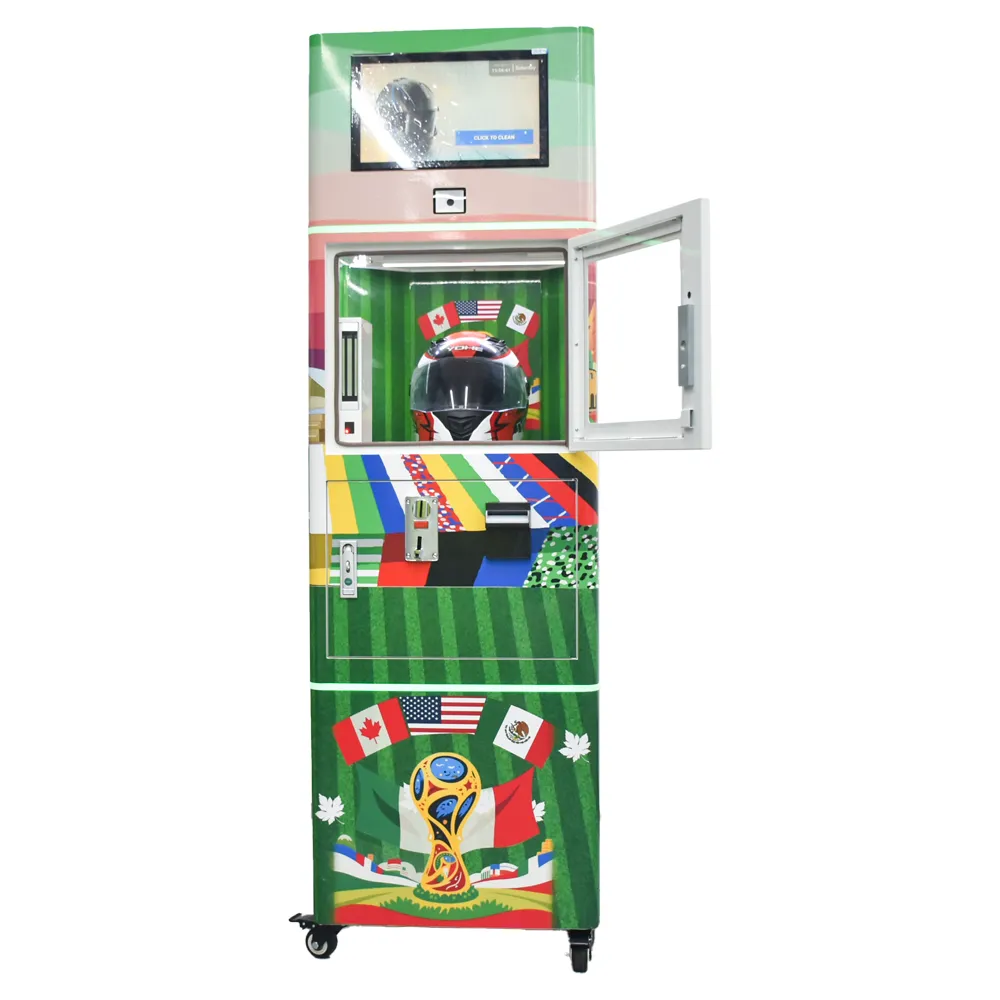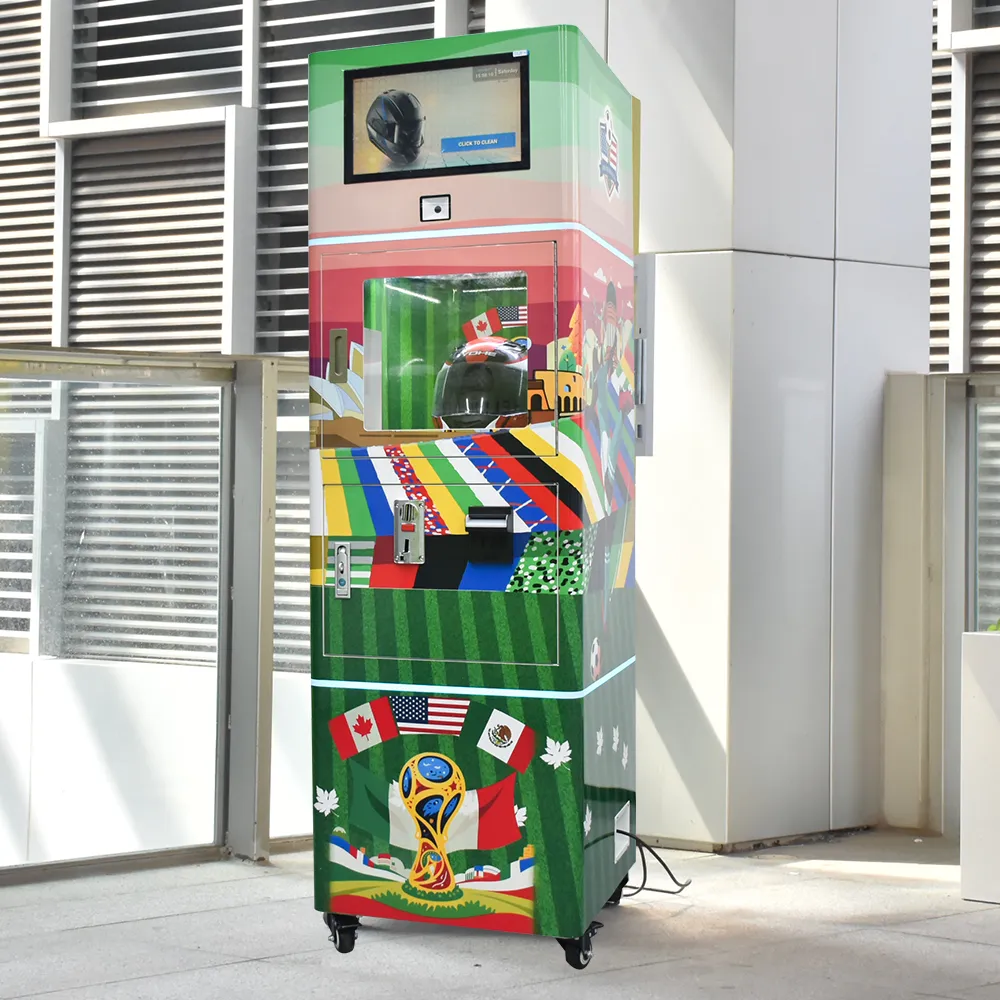הגברת רמות ההיגיינה של כובעים בסביבות מודרניות
במהלך ש Awareness הציבורית לhygiene אישי וsafety בריאות ממשיכה לגדול, עסקים שפועלים בסביבות משותפות של קסדות, כגון חנויות להשכרת אופנועים, מסילות גוקרט, חברות בנייה וחברות משלוחים, מחפשים בדרכים יעילות יותר לשמור על ניקיון הקסדות. בהקשר זה, מכונת ניקוי הקסדות צומחת כתשובה מתקדמת המציעת גישת ניקוי מקיפה. המכונה, שפותחה במטרה לאחד בתוכה פונקציות של סטריליזציה, הסרת ריחות ויבוש מהיר, הופכת את ה-hygiene של הקסדות על ידי מתן חוויית משתמש בטוחה, טרייה ומקצועית יותר.
STERILIZATION משולב לHYGIENE מירבית
UV-C טכנולוגיה להשמידת גermen
אחד המרכיבים המרכזיים של מכונה מודרנית מכונה לניקוי קסדות הוא מערכת הסטריליזציה המובנית UV-C. טכנולוגיה זו משתמשת באור אולטראסגול כדי לפרק את ה-DNA של חיידקים, נגיפים ופטריות, ומבטלת את פעילותם. exposures קצרה של מספר דקות בלבד, הכפפות מוסרו בצורה אפקטיבית, ומנועדת סיכון של זיהום צולב בין משתמשים. סטריליזציה UV-C אינה משתמשת בمواد כימיות, היא ידידותית לסביבה ויעילה מאוד, מה שהופך אותה לשיטה מהימנה במגוון יישומים רפואיים ותעשייתיים.
סטריליזציה באוזון ובחום ככלי עזר
מעבר לאור UV-C, חלק מהמכשורים מכונות ניקוי קסדות משתמשים בסטריליזציה באוזון או ייבוש בטמפרטורה גבוהה כדי להבטיח ניקיון מעמיק. מולקולות האוזון חודרות לשכבת הפסולת והבד של הכפפה, ומביאות לחמצון של מיקרואורגניזמים שנותרו. באופן דומה, ייבוש בחום לא רק שמסיר את הלחות אלא גם תורם לסטיריליזציה. ביחד, תכונות אלו מעלות את הביצועים של המכונה, ונותנות ללקוחות ולמפעילי המכונה alike שלווה בנפש.

דיאודורציה מתקדמת לשמירה על טריות
מערכות פחמן פעיל ויינון
إزالة ריחות היא היבט קריטי בניקוי כובעים, במיוחד עבור פריטים המשמשים מספר משתמשים בסביבות לחות או חמות. מכונות ניקוי כובעים נוטות להשתמש בסינורי פיח פעיל או יוניזציה כדי לאפס ריחות. מערכות אלו סופגות או מפורקות חלקיקים גורמי ריח, ומשאירות את הכובעים מריחנים ונטולי ריח מלאכותי, שיכול לגרום לתגובות אלרגיות لدى משתמשים רגישים.
הזרקת שמן אתרי להנאהת המשתמש
כדי להעצים את חוויית המשתמש, מספקות חלק מהמכונות את האפשרות להזריק טפטוף קל של שמן אתרי בסיום מחזור הניקוי. פעולה זו משאירה ריח נעים, וכן מספקת יתרונות אנטי-בקטריאליים קלים, במיוחד כאשר משתמשים בשמנים טבעיים כמו שמן עץ התה או לבנדר. שילובם של תכונות אלו מדגיש את גיוון היישומים של המכונה ואת תכנונה המכוון ללקוח.
פעולה חוסכת זמן וmanpower
תהליך אוטומטי להשלמה מהירה
יתרון מרכזי של מכונת ניקוי הקסדות הוא התהליך האוטומטי המלא שלה. המפעילים פשוט מכניסים את הקסדה, בוחרים את מצב הניקוי הרצוי, והמכונה מטפלת בשאר. זה מיישר פעילות, במיוחד בתרחישים בעלי נפח גדול כגון תחנות שיתוף אופניים או חדרי ציוד בנייה. רוב המכונות יכולות להשלים את מחזור ניקוי מלא בפחות מחמש דקות, מקצץ באופן דרמטי את זמן הפסקת הפעילות.
שימור נמוך והעמדת ארוכת טווח
מכונות ניקוי קסדות מעוצבות עם רכיבים ברמה תעשייתית, להבטיח עמידות ארוכה ושימור מינימלי. תכונות כמו דוחפים ניקוי עצמי, מסננים ניתנים להסרה, וכלים דיגיטליים לאבחנה מקטין את הצורך שירות המחאות. זה לא רק חוסך עלויות כוח אדם אלא גם משפר את יעילות התפעול הכללית, מה שהופך אותו להשקעה חכמה לכל עסק.
עיצוב וממשק ידידותי לשימוש
ממשק מסך מגע רב-לשוני
קלות השימוש היא עדיפות בישומים ציבוריים או מסחריים. רוב מכונות הכביסה למסכות מצוידות במקלדות טרומיות אינטואיטיביות התומכות בכמה שפות, מה שמאפשר הכשרה מהירה ותפעול חלק. ההוראות לרוב מופיעות עם איורים כדי לאפשר שימוש לקהלים עם רמות שונות של דפדוף טכנולוגי.
קומפקטיות וניידות
למרות יכולות הביצוע הגבוהות שלהן, המכונות הללו לרוב קומפקטיות ו적אומות לתוך מרווחים מצומצמים כמו פינות חנות או נקודות כניסה למחסנים. דגמים מסוימים מצוידים בגלגלים או בمقבים לצורך העברה קלה. עיצובן החוסך מרווח מבטיח כי הן יוכלו להשתלב בטווח רחב של סביבות עסקיות מבלי צורך בהרחבה או שינויי תכנון נרחבים.
שיפור תמונת המותג באמצעות ניקיון
בניית אמון ו נאמנות הלקוחות
הצגת קסדות נקיות בקביעות היא עדות למחויבותה של החברה להיגיינה ולבטחת הלקוחות. על ידי השקעה במכונת ניקוי קסדות, עסקים יכולים להפגין מקצועיות ודאגה, מה שמוביל ליצירת אמון וקידום נאמנות הלקוח. ציוד נקי הוא לא רק עניין אסתטי - זה עניין של הפגנת כבוד כלפי הלקוחות והעובדים שלך.
הבדלה בשווקים מתחריים
בתעשייה תחרותית, מערכות ניקוי מתקדמות כמו מכונת ניקוי קסדות יכולות לשמש כנקודת מכירה ייחודית. לקוחות נוטים לבחור בשירותים שמניחים דגש על ניקיון, במיוחד בסביבה בריאותית של ימינו. הדגשת תכונה זו בחומרי שיווק יכולה לספק לעסק שלך יתרון תחרותי.
הטבות סביבתיות ויעילות אנרגטית
שיטות ניקוי ידידותיות לסביבה
מכונות ניקוי כובעים מודרניות נועדו עם חשיבה של קיימות. דגמים רבים משתמשים במים מזעריים ומנמנעים שימוש בכימיקלים אגרסיביים, ומביאים במקום זה אור UV, אוזון או יינון. שיטות אלו הן בטוחות יותר הן למשתמשים והן לסביבה. שימוש במכונת ניקוי כובעים תומך באיניציוטיבות ירוקות ועוקב אחרי הביקוש הגובר לפתרונות תושבים-סביבתיים.
טכנולוגיה טכנולוגיה שמירת אנרגיה
בנוסף להיותן ידידותיות לסביבה, לרוב מכונות אלו משולבות רכיבים חוסכי אנרגיה כמו נורות נמוכות בואט, מחזורים עם שעון ודרכי סטנדבי. פעולה זו מפחיתה את צריכת החשמל והעלויות התפעוליות, מה שעושה את המכשירים עוד יותר מושכים לשימוש ארוך טווח.
גיוון בישומים בתעשייה
ריאות כובעים בשירותי תחבורה
בין אם מדובר במכשורים על אופנועים, שכירת סקוטרים או שירותים לשיתוף אופניים, מכונת ניקוי כובעים מספקת פתרון המבטיח שכל רוכב יקבל כובע מוסדר. פעולה זו לא רק שמשפרת את שביעות הרצון של הלקוחות, אלא גם עונה על דרישות של בריאות ובטיחות הנפוצות באזורי מגורים רבים.
פתרונות לתחום התעשייתי ולספורט
במקומות עבודה שבהם קסדות הן חלק מהציוד היומיומי - כגון מפעלים, מכרות או מרכזי אימונים לספורט - שמירה על היגיינת הקסדות היא קריטית. מכונת ניקוי קסדות מציעה פתרון יעיל ומרכזי לניהול כמויות גדולות של ציוד, ייעול הלוגיסטיקה ושיפור פרוטוקולי הבריאות במקום העבודה.
ערך לטווח ארוך וחזר ההשקעה
יעילות עלות לאורך זמן
למרות שהשקעה התחלתית עשויה להיראות גבוהה, מכונת ניקוי הכובעים מספקת ערך דרך הפחתת עלויות עבודה, הקצאת זמן טיפול קצרה יותר ועלייה בשיעור החזקה של הלקוחות. היכולת לנקות יותר כובעים בפחות זמן תורמת ישירות להגברת תפוקת העבודה ועלייה ברווחים שירות יְכוֹלֶת.
תמיכה בצמיחה עסקית
על ידי שילוב של מכונת ניקוי כובעים לתפעול, חברות ממקדות את עצמן לקראת צמיחה במתכונת גמישה. בין אם מתרחבות לאתרים חדשים ובין אם מגדילות את throughout שירות השימוש בפתרון ניקוי מהימן תומך בפיתוח עתידי ושמור על מוניטין המותג.
שאלות נפוצות
כמה זמן נמשך מחזור ניקוי מלא במכונת ניקוי כובעים?
לרוב, מכונות ניקוי כובעים מסיימות מחזור סטריליזציה ודיאודוריזציה מלא תוך 3 עד 5 דקות, תלוי בדגם והגדרות שנבחרו.
האם מכונות ניקוי כובעים בטוחות לשימוש בכל סוגי הכובעים?
כן, ברוב המקרים המכונות מוצבות כך שיתאימו לחומרים ושילובים שונים של כובעים, כולל כובעים עם רטיטה פוליאתילן וכובעים עם קליפה קשה. עם זאת, מומלץ לבדוק את ההתאמה על פי הנחיות היצרן.
האם למכונות ניקוי כובעים יש צורך בהתקנה מיוחדת?
לרוב, מכונות אלו הן מסוג פלט-앤피יל (plug-and-play) ודורשות רק חיבור חשמלי סטנדרטי. ייתכן שדגם מסוים יזדקקו לתמיכה קלילה בתרבויות אם נעשה שימוש בתפקידי יבוש חמצן או חום.
האם ניתן להתאים אישית את הריח או התכונות של מכונת הנקה למיכלים?
רבים מהדגמים מציעים תכונות אופציונליות כגון הזרקת שמן אתרי, זמן יבוש ניתן להתאמה, וממשק משתמש מרובשפותי. ההתאמה תלויה בייצרן ובмֹדֵל הספציפי.
